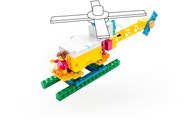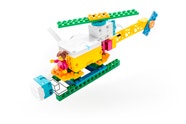Hovering Helicopter
Help Maria get to Spike Mountain for a hike!

Prepare
- Review the Hovering Helicopter lesson in the LEGO® Education SPIKE™ App.
- Consider the abilities and backgrounds of all your pupils. Differentiate the lesson to make it accessible to everyone. Please refer to the Differentiation section below for suggestions on how to do this.
- If time permits, plan and facilitate the language arts extension. Please refer to the Extension section below for further information.
Engage
(Whole Class, 5 Minutes)
- Facilitate a quick discussion about describing a decision, choice, or experience to a friend.
- Talk with your pupils about telling a friend about a new experience (e.g. an activity or movie).
- Ask questions like these: How do you feel when you tell someone about a new experience you have had? Why do you think it is valuable to share your experiences?
- Introduce your pupils to the story’s main characters and the first challenge: starting the helicopter.
- Distribute a brick set and a device to each group.
Explore
(Small Groups, 30 Minutes)
- Have your pupils use the LEGO® Education SPIKE™ App to guide them through their first challenge:
- Create and test the program that starts the helicopter.
- Have your pupils iterate and test their models to complete the next two challenges in the app:
- Create the program that makes the helicopter act differently when it has been tilted.
- Upgrade the helicopter for Maria’s next adventure.
- You can find coding and building help in the Tips section below.
Explain
(Whole Class, 5 Minutes)
- Gather your pupils together to reflect on their completed challenges.
- Ask questions like these: How did Maria’s helicopter get to Spike Mountain? How did you modify Maria’s helicopter in order to improve it for her next adventure?
Elaborate
(Whole Class, 5 Minutes)
- Prompt your pupils to discuss and reflect on the choices they have made while developing their programs.
- Ask questions like these: Why is it important to describe the choices you have made while creating your program? How can describing your program to others help you to improve it?
- Have your pupils tidy up their workstations.
Evaluate
(Ongoing Throughout the Lesson)
- Ask guiding questions to encourage your pupils to ‘think aloud’ and explain their thought processes and reasoning in the decisions they have made while building and programming their models.
Observation Checklist
- Measure your pupils’ proficiency in describing the choices they have made while developing their programs.
- Establish a scale that suits your needs. For example:
- Requires additional support
- Can work independently
- Can teach others
Self-Assessment
Have each pupil choose the brick that they feel best represents their performance.
- Yellow: I think that I can explain the decisions I have made while developing my program.
- Blue: I can explain the decisions I have made while developing my program.
- Green: I can explain the decisions I have made while developing my program, and I can also help a friend to do it.
Peer Feedback
- In their small groups, have your pupils discuss their experiences working together.
- Encourage them to use statements like these:
- I liked it when you…
- I would like to hear more about how you…
Tips
Coding Tips
- After your pupils have completed their first challenge, they will be provided with a map.
- Using the map, your pupils can experiment with the available Coding Blocks to modify their programs to follow the route for the trip.




Model Tip
- After your pupils have completed their second challenge, they will be provided with three Inspiration Images and an open-ended prompt, which will help them to improve their models.
- The Inspiration Images are meant to help spark their imaginations as they experiment and change their models.




There are no specific building instructions for this challenge.
Differentiation
Simplify this lesson by:
- Reading the Hovering Helicopter story and instructions from the LEGO® Education SPIKE™ App aloud to your pupils
- Selecting one Inspiration Image to help your pupils to change their models
Increase the difficulty by:
- Adding the Colour Sensor or another motor to Maria’s helicopter
- Pairing up groups of pupils and asking them to explain their programs and suggest improvements to one another
Extension
- Have your pupils write narratives about what Maria sees, hears, smells, and feels while she is on her hike.
If facilitated, this will extend beyond the 45-minute lesson.
ACELA1477
Examine how evaluative language can be varied to be more or less forceful
Teacher Support
The pupils will:
- Describe the choices that they have made when creating a program
- Create and test automated solutions
- Recount an experience using relevant facts and descriptive details
(one for every two pupils)
- LEGO® Education SPIKE™ Essential Set
- Device with the LEGO® Education SPIKE™ App installed
Design and Technologies
ACTDEK010
Recognise the role of people in design and technologies occupations and explore factors, including sustainability that impact on the design of products, services, and environments to meet community needs.
Digital Technologies
ACTDIP011
Implement simple digital solutions as visual programs with algorithms involving branching (decisions) and user input.
English Language
ACELA1477
Examine how evaluative language can be varied to be more or less forceful.